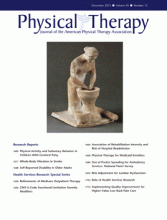Abstract
Background Whole-body vibration (WBV) has increasingly been used as an adjunct treatment in neurological rehabilitation. However, how muscle activation level changes during exposure to different WBV protocols in individuals after stroke remains understudied.
Objective The purpose of this study was to examine the influence of WBV intensity on the magnitude of biceps femoris (BF) and tibialis anterior (TA) muscle activity and its interaction with exercise and with severity of motor impairment and spasticity among individuals with chronic stroke.
Methods Each of the 36 individuals with chronic stroke (mean age=57.3 years, SD=10.7) performed 8 different static exercises under 3 WBV conditions: (1) no WBV, (2) low-intensity WBV (frequency=20 Hz, amplitude=0.60 mm, peak acceleration=0.96g), and (3) high-intensity WBV (30 Hz, 0.44 mm, 1.61g). The levels of bilateral TA and BF muscle activity were recorded using surface electromyography (EMG).
Results The main effect of intensity was significant. Exposure to the low-intensity and high-intensity protocols led to a significantly greater increase in normalized BF and TA muscle electromyographic magnitude in both legs compared with no WBV. The intensity × exercise interaction also was significant, suggesting that the WBV-induced increase in EMG activity was exercise dependent. The EMG responses to WBV were similar between the paretic and nonparetic legs and were not associated with level of lower extremity motor impairment and spasticity.
Limitations Leg muscle activity was measured during static exercises only.
Conclusions Adding WBV during exercise significantly increased EMG activity in the TA and BF muscles. The EMG responses to WBV in the paretic and nonparetic legs were similar and were not related to degree of motor impairment and spasticity. The findings are useful for guiding the design of WBV training protocols for people with stroke.
Footnotes
Mr Liao, Professor Ng, Professor Jones, and Professor Pang provided concept/idea/research design and writing. Mr Liao provided data collection. Mr Liao, Dr Chung, and Professor Pang provided data analysis. Professor Pang provided project management, fund procurement, study participants, and facilities/equipment. Professor Ng, Professor Jones, Dr Chung, and Professor Pang provided consultation (including review of manuscript before submission).
The study was approved by the Human Subjects Ethics Subcommittee of the Hong Kong Polytechnic University (approval number: HSEARS20130209001-01), and all experiments were conducted in accordance with the Declaration of Helsinki.
The work described in this article was substantially supported by a grant from the Research Grants Council of the Hong Kong Special Administrative Region, China (Project No. PolyU 5245/11E).
The experiments comply with the current laws of the country in which they were performed.
- Received November 9, 2014.
- Accepted May 20, 2015.












